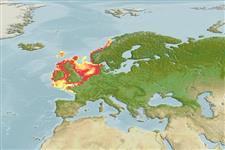Common names from other countries
Environment: milieu / climate zone / depth range / distribution range
Ekologi
laut; payau dasar (demersal); oceanodromus (Ref. 51243); kisaran kedalaman 0 - 100 m (Ref. 35388), usually 10 - 20 m (Ref. 1371). Temperate; 68°N - 44°N, 11°W - 13°E
Northeast Atlantic: Trondheim on the Norwegian coast to the Bay of Biscay; also around the British Isles.
Size / Weight / umur
Maturity: Lm ? range ? - ? cm
Max length : 30.0 cm TL jantan/; (Ref. 1371); common length : 20.0 cm TL jantan/; (Ref. 4645)
Duri punggung (Keseluruhan (total)) : 0; Duri dubur: 0. Head depressed. First dorsal fin poorly developed, with only three short rays. Color uniformly dark brown or bluish brown; the lips and the distal areas of all fins paler except for the pectorals.
Lives in coastal waters at shallow depths, generally from 10-20 m, more seldom from 75-100 m, on rocky bottom with seaweeds. Solitary and secretive, undertakes only limited local movements. Spawns from May to September at 50-70 m depth near the shore throughout its entire range. Feeds on sea stars, crustaceans, worms, mollusks and small fish (Ref. 1371).
Oviparous, sexes are separate (Ref. 205).
Cohen, D.M., T. Inada, T. Iwamoto and N. Scialabba, 1990. FAO species catalogue. Vol. 10. Gadiform fishes of the world (Order Gadiformes). An annotated and illustrated catalogue of cods, hakes, grenadiers and other gadiform fishes known to date. FAO Fish. Synop. 125(10). Rome: FAO. 442 p. (Ref. 1371)
Status IUCN Red List (Ref. 130435)
CITES (Ref. 128078)
Not Evaluated
ancaman kepada manusia
Harmless
penggunaan manusia
Perikanan: tidak ada kepentingan; Akuarium: Akuarium publik
Alat, peralatan
laporan khas
muat turun XML
Sumber internet
Estimates based on models
Preferred temperature (Ref.
115969): 8.5 - 12.5, mean 10.4 (based on 120 cells).
Phylogenetic diversity index (Ref.
82804): PD
50 = 1.0000 [Uniqueness, from 0.5 = low to 2.0 = high].
Bayesian length-weight: a=0.01072 (0.00412 - 0.02789), b=3.06 (2.83 - 3.29), in cm Total Length, based on LWR estimates for this (Sub)family-body shape (Ref.
93245).
Trophic level (Ref.
69278): 3.8 ±0.56 se; based on food items.
Fishing Vulnerability (Ref.
59153): Low vulnerability (20 of 100).
